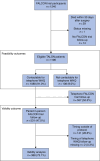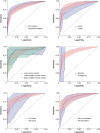Accuracy of the Wound Healing Questionnaire in the diagnosis of surgical-site infection after abdominal surgery in low- and middle-income countries
- PMID: 38747515
- PMCID: PMC10895408
- DOI: 10.1093/bjs/znad446
Accuracy of the Wound Healing Questionnaire in the diagnosis of surgical-site infection after abdominal surgery in low- and middle-income countries
Erratum in
-
Erratum to: Accuracy of the Wound Healing Questionnaire in the diagnosis of surgical-site infection after abdominal surgery in low- and middle-income countries.Br J Surg. 2024 Mar 2;111(3):znae069. doi: 10.1093/bjs/znae069. Br J Surg. 2024. PMID: 38459903 Free PMC article. No abstract available.
Abstract
Introduction: Telemedicine is being adopted for postoperative surveillance but requires evaluation for efficacy. This study tested a telephone Wound Healing Questionnaire (WHQ) to diagnose surgical site infection (SSI) after abdominal surgery in low- and middle-income countries.
Method: A multi-centre, international, prospective study was embedded in the FALCON trial; a factorial RCT testing measures to reduce SSI in seven low- and middle-income countries (NCT03700749). It was conducted according to a pre-registered protocol (SWAT126) and reported according to STARD guidelines. The reference test was in-person review by a trained clinician at 30 postoperative days according to US Centres for Disease Control criteria. The index test was telephone administration of an adapted WHQ at 27 to 30 postoperative days by a researcher blinded to the outcome of in-person review. The sum of item response scores generated an overall score between 0 and 29. The primary outcome was the diagnostic accuracy of the WHQ, defined as the proportion of SSI correctly identified by the telephone WHQ, and summarized using the area under the receiving operator characteristic curve (AUROC) and diagnostic test accuracy statistics.
Results: Patients were included from three upper-middle income (396 patients, 13 hospitals), three lower-middle income (746 patients, 19 hospitals), and one low-income country (54 patients, 4 hospitals). 90.3% (1088 of 1196) patients were successfully contacted. Those with non-midline incisions (adjusted odds ratio: 0.36, 95% c.i. 0.17 to 0.73, P=0.005) or a confirmed diagnosis of SSI on in-person assessment (odds ratio: 0.42, 95% c.i. 0.20 to 0.92, P=0.006) were harder to reach. The questionnaire correctly discriminated between most patients with and without SSI (AUROC 0.869, 95% c.i. 0.824 to 0.914), which was consistent across subgroups. A representative cut-off score of ≥4 displayed a sensitivity of 0.701 (0.610-0.792), specificity of 0.911 (0.878-0.943), positive predictive value of 0.723 (0.633-0.814) and negative predictive value of 0.901 (0.867-0.935).
Conclusion: SSI can be diagnosed using a telephone questionnaire (obviating in-person assessment) in low resource settings.
Plain language summary
A wound infection happens when germs enter the cut made in your body by a doctor when you are operated on. Germs are small organisms that cannot be seen by your eyes, but they can cause problems in the healing of the cut. Infection is the most common problem after surgery and can delay you getting out of hospital and back to normal life. The current way to check whether you have an infection is for a doctor or nurse to look at the cut made on your tummy and see how it is healing. For example, a doctor may check if the cut has a green liquid oozing from it or if the area of the wound is red or swollen. A month after you leave hospital, a doctor may ask you to come back for a follow-up visit. However, this will require you to travel to hospital and take a day off work or away from your family, and can be expensive and time-consuming if you travel far. We wanted to find out if talking to a doctor over the phone would work as well as you travelling to hospital to show the wound to a doctor or nurse in person. To do this, we asked over 1000 patients who had recently undergone surgery to be checked using both methods—to take a phone call from one doctor and be checked in person by a different doctor. We were able to compare the phone follow-up and in-person check to see if the doctors came to a different conclusion. We also looked at whether patients were able to receive a phone call at home and their experience of the process. For most patients, the phone call from a doctor was just as good at seeing if a patient had an infection as a face-to-face check-up by a doctor. However, the phone call was not perfect all the time, particularly for patients with very mild infections. Most patients were able to receive the phone call after a few tries and all patients were very happy with the process. As an international research team, we are now trying new ways to improve the phone call, including looking at the wound over video if possible. A phone call to check how your wound is healing can now be used as a substitute for a face-to-face check-up by a doctor. If you have any worries about your wound after the phone call you should still seek help from a doctor or nurse. We hope that the phone call will be more convenient for patients like you to avoid travelling back to hospital and taking time away from your work and family.
© The Author(s) 2024. Published by Oxford University Press on behalf of BJS Foundation Ltd.
Figures



References
-
- Allegranzi B, Bagheri Nejad S, Combescure C, Graafmans W, Attar H, Donaldson L et al. Burden of endemic health-care-associated infection in developing countries: systematic review and meta-analysis. Lancet 2011;377:228–241 - PubMed
-
- Astagneau P, Rioux C, Golliot F, Brucker G. Morbidity and mortality associated with surgical site infections: results from the 1997–1999 INCISO surveillance. J Hosp Infect 2001;48:267–274 - PubMed
-
- Gheorghe A, Moran G, Duffy H, Roberts T, Pinkney T, Calvert M. Health utility values associated with surgical site infection: a systematic review. Value Health 2015;18:1126–1137 - PubMed
-
- National Institute for Health Research Global Health Research Unit on Global Surgery . Prioritizing research for patients requiring surgery in low- and middle-income countries. Br J Surg 2019;106:e113–e120 - PubMed
Publication types
MeSH terms
Associated data
Grants and funding
LinkOut - more resources
Full Text Sources
Medical
Research Materials
Miscellaneous

